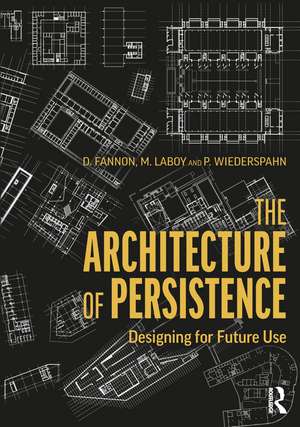The Architecture of Persistence: Designing for Future Use
Autor David Fannon, Michelle Laboy, Peter Wiederspahnen Limba Engleză Paperback – 25 aug 2021
Organized in three parts, this book examines material longevity in the face of constant physical and cultural change, connects the dimensions of human use and contemporary program, and discusses how time informs the design process. Featuring dozens of interviews with people who design and use buildings, and a close analysis of over a hundred historic and contemporary projects, the principles of persistent architecture introduced here address urgent challenges for contemporary practice while pointing towards a more sustainable built environment in the future.
The Architecture of Persistence: Designing for Future Use offers practitioners, students, and scholars a set of principles and illustrative precedents exploring architecture’s unique ability to connect an instructive past, a useful present, and an unknown future.
Preț: 237.06 lei
Preț vechi: 282.41 lei
-16% Nou
Puncte Express: 356
Preț estimativ în valută:
45.36€ • 48.51$ • 37.82£
45.36€ • 48.51$ • 37.82£
Carte tipărită la comandă
Livrare economică 17 aprilie-01 mai
Preluare comenzi: 021 569.72.76
Specificații
ISBN-13: 9780367486372
ISBN-10: 0367486377
Pagini: 312
Ilustrații: 262
Dimensiuni: 178 x 254 x 30 mm
Greutate: 0.56 kg
Ediția:1
Editura: Taylor & Francis
Colecția Routledge
Locul publicării:Oxford, United Kingdom
ISBN-10: 0367486377
Pagini: 312
Ilustrații: 262
Dimensiuni: 178 x 254 x 30 mm
Greutate: 0.56 kg
Ediția:1
Editura: Taylor & Francis
Colecția Routledge
Locul publicării:Oxford, United Kingdom
Public țintă
Postgraduate, Undergraduate Advanced, and Undergraduate CoreCuprins
Introduction: Motive, Context, Method Part I. Material Ecologies 1. Essential 2. Durable 3. Simple 4. Situated Part II. Changing Uses 5. Timely 6. Humane 7. Complex 8. Anticipatory Part III. Alternative Futures 9. Memorable 10. Evolving 11. Indeterminate 12. Timeless Conclusion: Towards an Architecture of Persistence
Notă biografică
D. Fannon is an architect and building scientist whose work integrates research and design to provide occupant comfort and wellbeing in long-lasting, low-resource consuming buildings. He is jointly appointed associate professor in the School of Architecture and the Department of Civil and Environmental Engineering at Northeastern University. David earned a Bachelor of Architecture degree from Rensselaer Polytechnic Institute, a master’s from UC Berkeley, and is a registered architect in the State of New York. He is a Member of ASHRAE and a LEED Accredited Professional with B+DC specialty.
M. Laboy is an assistant professor in the School of Architecture at Northeastern University, with affiliate appointments in the Department of Civil and Environmental Engineering and the School of Public Policy and Urban Affairs. As co-founder of FieLDworkshop LLC, she leads research-based transdisciplinary approaches to heighten the connections between people, buildings, and landscapes. Her research and teaching examine how socio-ecological thinking influences architectural theory and practice to shape human experience, performance, and adaptability to dynamically changing environments. Michelle holds a Master of Architecture and a Master of Urban Planning from the University of Michigan and a Bachelor of Science in Civil Engineering from the University of Puerto Rico, and is registered as a Professional Engineer.
P. Wiederspahn is an associate professor at Northeastern University, Boston, MA, and principal of Wiederspahn Architecture, LLC. His research and pedagogy are focused on architectural design, production, performance, and systems. In particular, he has conducted research on: wood construction and its cultural impact at the detail, architectural, and urban scales; high-performance, rapid-assembly, structural/thermal component construction system as an alternative to wood framing; light-weight flat-pack, rapid-deployment, long-term-use emergency shelter systems; and furniture design. His architectural practice has received numerous design excellence awards for residential, multi-family, commercial, and interior architecture projects. Peter earned his Bachelor of Architecture from Syracuse University and his Master of Architecture from the Harvard University.
M. Laboy is an assistant professor in the School of Architecture at Northeastern University, with affiliate appointments in the Department of Civil and Environmental Engineering and the School of Public Policy and Urban Affairs. As co-founder of FieLDworkshop LLC, she leads research-based transdisciplinary approaches to heighten the connections between people, buildings, and landscapes. Her research and teaching examine how socio-ecological thinking influences architectural theory and practice to shape human experience, performance, and adaptability to dynamically changing environments. Michelle holds a Master of Architecture and a Master of Urban Planning from the University of Michigan and a Bachelor of Science in Civil Engineering from the University of Puerto Rico, and is registered as a Professional Engineer.
P. Wiederspahn is an associate professor at Northeastern University, Boston, MA, and principal of Wiederspahn Architecture, LLC. His research and pedagogy are focused on architectural design, production, performance, and systems. In particular, he has conducted research on: wood construction and its cultural impact at the detail, architectural, and urban scales; high-performance, rapid-assembly, structural/thermal component construction system as an alternative to wood framing; light-weight flat-pack, rapid-deployment, long-term-use emergency shelter systems; and furniture design. His architectural practice has received numerous design excellence awards for residential, multi-family, commercial, and interior architecture projects. Peter earned his Bachelor of Architecture from Syracuse University and his Master of Architecture from the Harvard University.
Descriere
The Architecture of Persistence argues that continued human use is the ultimate measure of sustainability in architecture, and that expanding the discourse about adaptability to include continuity as well as change offers the architectural manifestation of resilience.
